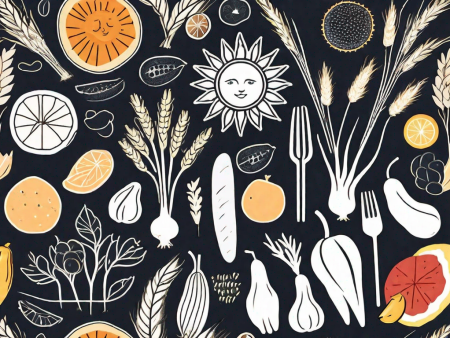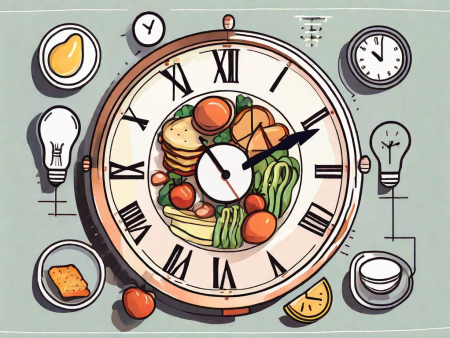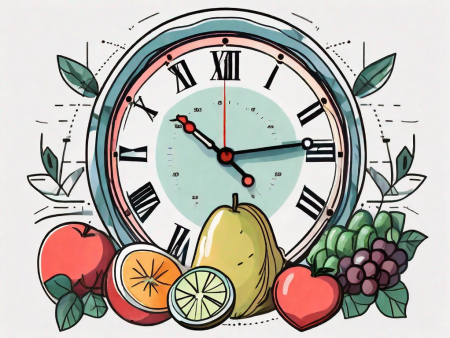Discover how metabolism changes as we age and the impact it has on our overall health and weight management.
How Does Metabolism Change With Age?
As we journey through life, our bodies go through a series of changes. One aspect that undergoes significant transformations is our metabolism. But what exactly is metabolism? How does it work? And what happens to it as we age? Buckle up, because we’re about to dive into the fascinating world of metabolism and its relationship with the aging process.

Understanding the Basics of Metabolism
Metabolism is like the engine that keeps our bodies running smoothly. It’s the complex process through which our bodies convert the food we eat into energy. Think of it as the ultimate power plant within us.
But metabolism isn’t a one-size-fits-all system. It consists of several key components, working together to keep us going:
The Role of Metabolism in the Body
The primary role of metabolism is to break down macronutrients like carbohydrates, fats, and proteins into smaller molecules. These molecules are then used by our cells to generate the energy needed for everyday tasks. From the simplest actions like breathing to more complex ones like dancing a salsa, metabolism is the unsung hero.
Additionally, metabolism plays a vital role in maintaining other essential bodily functions, such as hormone regulation, cell repair, and toxin elimination. In short, it’s a superhero multitasker!
Key Components of Metabolism
Metabolism is made up of two main components:
- Basal Metabolic Rate (BMR): This is the energy your body requires at rest to perform basic functions like breathing and circulating blood. It accounts for about 60-75% of your total energy expenditure.
- Physical Activity and Thermic Effect of Food (TEF): This includes the energy burned during exercise and the energy used to digest, absorb, and process the food you eat. Together, physical activity and TEF make up the remaining 25-40% of your energy expenditure.
Now that we have a solid grasp on the fundamentals, let’s tackle the grand question: How does aging impact this sensational metabolic symphony?
Aging is a natural part of life, and it affects every aspect of our bodies, including metabolism. As we age, our metabolic rate tends to slow down. This means that our bodies require fewer calories to perform the same tasks. It’s like the engine of our metabolism is running at a slightly lower speed.
One reason for this slowdown is the loss of muscle mass that often occurs with age. Muscle tissue is more metabolically active than fat tissue, meaning it burns more calories even at rest. So, as we lose muscle mass, our metabolic rate decreases. This is why it’s important to engage in regular strength training exercises as we get older, to help preserve and build muscle.
Another factor that can impact metabolism with age is hormonal changes. Hormones play a significant role in regulating metabolism, and as we age, hormone levels can fluctuate. For example, menopause in women is associated with a decrease in estrogen levels, which can lead to weight gain and a slower metabolism.
Furthermore, lifestyle factors can also influence metabolism as we age. Poor diet, lack of physical activity, and chronic stress can all contribute to a slower metabolic rate. On the other hand, adopting healthy habits like eating a balanced diet, staying active, and managing stress can help support a healthy metabolism, even as we age.
In conclusion, metabolism is a fascinating and intricate process that keeps our bodies functioning. Understanding its basics, such as its role in breaking down nutrients and the key components that make it up, is essential. Additionally, recognizing how aging impacts metabolism allows us to make informed choices to support our overall health and well-being.
The Aging Process and Its Impact on Metabolism
Aging is a natural part of life, and just like the latest trends, our metabolism isn’t immune to its effects. Several biological changes occur as we age, leading to alterations in our metabolic rate – the speed at which our bodies burn calories. Let’s break down these changes:
Biological Changes with Age
As the years pass, our bodies experience a decrease in muscle mass and an increase in fat mass. This shift in body composition affects our metabolism because muscle tissue burns more calories at rest than fat tissue does. It’s like swapping your energy-efficient sports car for a vintage steam engine.
But what exactly happens to our muscles as we age? Well, it’s not just a matter of losing muscle mass. The quality of our muscle fibers also changes. With age, we tend to lose fast-twitch muscle fibers, which are responsible for explosive movements and power. Instead, we accumulate more slow-twitch muscle fibers, which are better suited for endurance activities. So, it’s not just about the quantity of muscle, but also the type of muscle that affects our metabolic rate.
Additionally, hormonal changes are also at play. With age, certain hormones that influence metabolism, such as thyroid hormones and growth hormones, tend to decrease. It’s like someone turned down the volume on your body’s metabolic beat.
But it’s not all doom and gloom. Despite these changes, our bodies are incredibly adaptable. Regular exercise, especially strength training, can help counteract the loss of muscle mass and maintain a higher metabolic rate. So, don’t let age discourage you from hitting the gym!
How Aging Affects Metabolic Rate
It’s no secret that our metabolism slows down as we age. This decline in metabolic rate can vary from person to person, but on average, it decreases by about 2-3% per decade after the age of 20. In simpler terms, it’s like someone dimmed the lights in your body’s metabolic nightclub.
But what does this mean for our daily calorie needs? Well, let’s say you were consuming 2000 calories a day in your twenties to maintain your weight. By the time you reach your fifties, you may only need around 1800 calories to maintain the same weight. That’s a difference of 200 calories, which can easily add up over time if not adjusted for.
This reduction in metabolic rate means that we require fewer calories to sustain our bodily functions. So, if you’ve noticed that you can’t devour an entire pizza without gaining weight like you used to, don’t blame your favorite food – it’s just your metabolism taking it easy on the dance floor.
But don’t despair! While our metabolic rate may decrease with age, there are still ways to keep it revved up. Eating a balanced diet, staying active, and getting enough sleep can all help support a healthy metabolism. So, even if the lights in your metabolic nightclub may be a bit dimmer, you can still keep the party going!
Specific Metabolic Changes in Different Age Groups
Metabolism isn’t a one-size-fits-all phenomenon. Its changes vary across different age groups. Let’s explore these changes and see what happens at each stage of life:
Metabolism in Childhood and Adolescence
During childhood and adolescence, our bodies are like a race car, revving their engines at full speed. Metabolic rates are high due to the rapid growth and development happening during this stage. It’s like your metabolism is throwing a wild party, burning calories left and right.
Metabolism Shifts in Adulthood
As we enter adulthood, our metabolism settles into a more moderate pace. It’s like upgrading from a race car to a reliable sedan. Our energy needs decrease slightly, but we still have plenty of fuel to power us through our daily adventures.
However, it’s important to note that lifestyle factors, such as diet and exercise habits, can significantly impact our metabolic rate in adulthood. That brings us to the next section: the magical relationship between metabolism, diet, and exercise.
The Relationship Between Metabolism, Diet, and Exercise
When it comes to metabolism, our diet and exercise choices can either be a party animal or a total buzzkill. Let’s find out how they influence our metabolic rate:
The Influence of Diet on Metabolism
Picture your metabolism as a fire that needs fuel. The food we eat serves as that fuel. Certain foods, such as protein and complex carbohydrates, require more energy to digest, giving your metabolism a slight boost. It’s like adding extra firewood to keep the metabolic flames burning.
On the other hand, crash diets or extreme calorie restriction can send your metabolism into survival mode. It’s like blowing out the candles on your body’s metabolic birthday cake. Your metabolism slows down to conserve energy, making it even harder to achieve your desired weight loss goals.
So, the key to a happy metabolic dance party is a balanced and nourishing diet. Don’t skip meals and include a variety of whole foods in your daily menu. Your metabolism will appreciate the culinary diversity!
The Effect of Exercise on Metabolic Rate
If diet is the fuel for your metabolism, then exercise is the energetic choreographer. Regular physical activity, especially strength training, helps to increase muscle mass. Remember, muscle tissue is a metabolic powerhouse, so the more you have, the more calories you burn at rest. It’s like adding extra fancy dance moves to your metabolic routine.
But don’t fret if you’re not into pumping iron like Arnold Schwarzenegger – any form of exercise can boost your metabolic rate. Whether it’s dancing, cycling, or even walking your dog, every little movement counts. So shake those hips or wag that tail – your metabolism will thank you!
Ways to Maintain a Healthy Metabolism as You Age
While it’s true that our metabolism may slow down with age, there are several lifestyle habits to keep the metabolic flames burning brightly. Let’s explore some tips and tricks:

Nutrition Tips for Supporting Metabolism
First and foremost, prioritize a diet rich in whole, nutrient-dense foods. Include plenty of fruits, vegetables, lean proteins, and whole grains in your meals. These foods provide the building blocks your body needs to keep the metabolic machinery in top shape.
Additionally, stay hydrated! Water helps maintain optimal metabolic function, so keep the H2O flowing like a refreshing waterfall.
Finally, don’t forget the importance of portion control. As we age, our bodies require fewer calories, so listen to your hunger and fullness cues. It’s like dancing to the rhythm of your own body’s metabolic beat.
Physical Activity Recommendations for Metabolic Health
To keep your metabolism on its toes, aim for at least 150 minutes of moderate-intensity aerobic exercise per week. This can include activities like brisk walking, swimming, or dancing with reckless abandon.
Don’t forget to squeeze in some muscle-strengthening exercises at least twice a week. Remember, the more muscle you have, the higher your metabolism dances. Treat those muscles like your body’s red-carpet VIP guests.
There you have it – a whirlwind journey through the intricate world of metabolism and its graceful dance with the aging process. While our metabolism may undergo changes, we now stand armed with knowledge about the ways we can support it. So, let’s raise a glass to our metabolism and continue to live life to the fullest, no matter the age!








Thank you for your sharing. I am worried that I lack creative ideas. It is your article that makes me full of hope. Thank you. But, I have a question, can you help me?
Your article helped me a lot, is there any more related content? Thanks!
Hi there! Do you know if they make any plugins to assist
with SEO? I’m trying to get my site to rank for some targeted keywords
but I’m not seeing very good results. If you know of any please share.
Many thanks! I saw similar blog here: Eco blankets